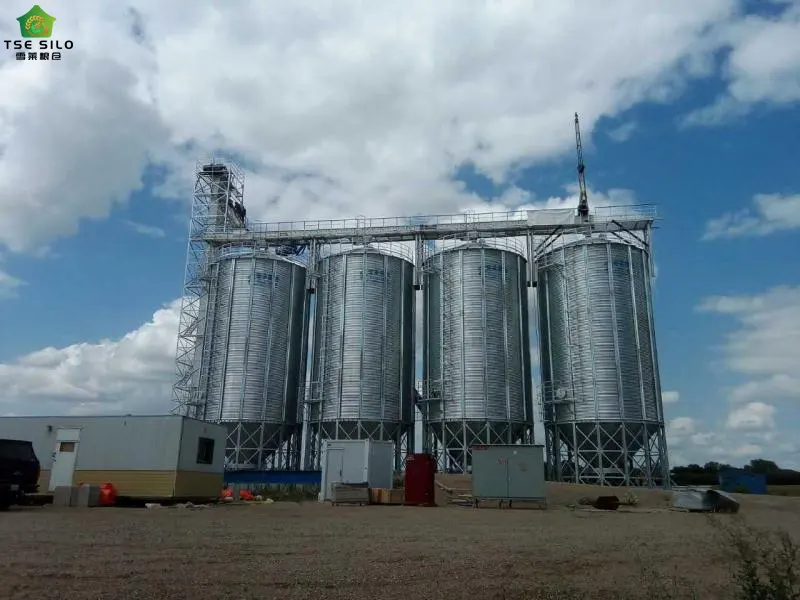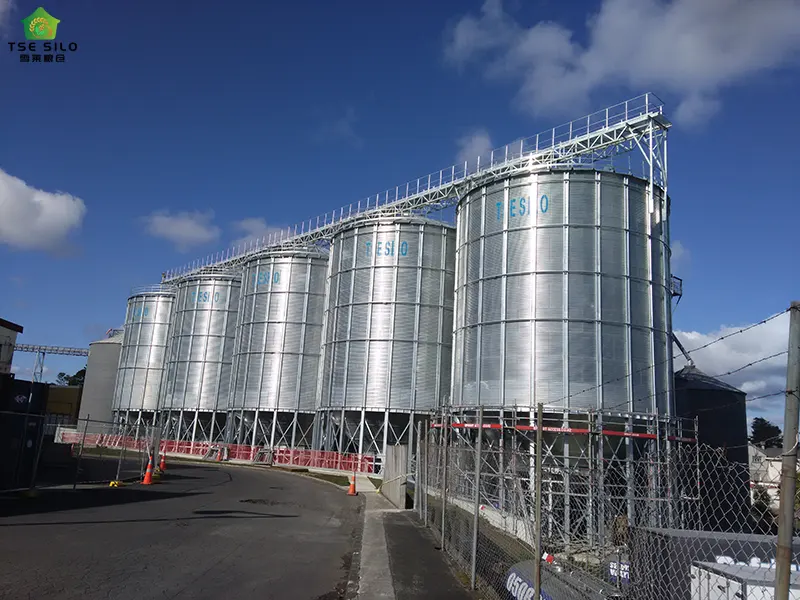In the market environment of grain steel silos, with the continuous increase in demand, many manufacturers, in pursuit of high profits, often resort to using inferior materials to deceive consumers, causing significant losses to many grain steel silo users. However, in the market, the price of inferior products cannot often be judged by appearance alone; steel silos with similar appearances often have vastly different prices. The core reason can be summarized as: "The layman sees the spectacle, the expert sees the details." Seemingly identical "iron houses" have differences in their internal materials, technology, processes, and services, directly determining their cost and final price. Today, Shelley Storage will explain several core reasons for the huge price differences.


1. Core Materials and Processes (Main Source of Cost Differences)
Materials are the most significant reason for the differences in grain steel silo processing. While appearances may be similar, the thickness of the plates used, the steel type, whether galvanized, and whether oxidation-resistant are used may differ. These are all key factors determining price. The main material cost of a steel silo accounts for as much as 60%-70%, and different types of steel have significant price differences. For example, Q345B (high-strength low-alloy steel) is 15%-20% more expensive than Q235B (ordinary carbon steel), while stainless steel can be 3-5 times more expensive than ordinary steel. Furthermore, the thickness of the silo wall directly affects its strength: storing high-density grains like corn requires 6-8mm thick steel plates, while storing rice may only require 4-5mm; for every 1mm increase in thickness, the cost increases by approximately 10%.
1.1. Steel Plate Material and Coating
- Low-cost silos: May use materials below national standards or plates produced by small factories. The galvanized layer is thin (e.g., less than 100 grams per square meter), with poor rust resistance, short service life, and will quickly rust and perforate in humid environments.
- High-cost silos: Use high-grade steel from reputable large manufacturers (such as Baosteel and Shougang), with a thick galvanized layer (up to 275 grams/㎡ or more), and may even use aluminum-zinc plating or more advanced anti-corrosion coatings, ensuring the silo body will not rust for 20-30 years.
1.2. Roll Forming Process
- Low-cost silos: Use outdated or rudimentary rolling equipment, resulting in poor forming accuracy and limited sheet shapes. The force and uniformity of the seam (sheet joint) are difficult to guarantee, directly affecting the airtightness and structural strength of the silo.
- High-cost silos: Employ imported or high-precision professional rolling production lines, ensuring precise dimensions and scientifically designed shapes for each sheet. The seam is tight and strong, able to withstand greater lateral material pressure, providing excellent airtightness and facilitating long-term safe grain storage.
1.3. Anti-corrosion Treatment Process
- Hot-dip galvanizing: Higher initial cost (approximately 50-70 RMB/㎡), but the zinc coating has a lifespan of 25-50 years, with an average annual maintenance cost of only 0.1 RMB/ton.
- Plastic coating/spraying: Lower cost (approximately 30-40 RMB/㎡), but requires re-treatment every 5-8 years; long-term maintenance costs may exceed those of hot-dip galvanizing.
- Composite Steel Plate: Such as the galvanized + nickel-plated double-layer material used in the Lipp process, costing 20%-30% more than ordinary steel plates, but offering 50% improved corrosion resistance.
2. Structural Design and Safety Factor
Although grain silos may look similar, their design standards differ significantly. For example, the design of earthquake and wind resistance, and supporting facilities, among other aspects, has a substantial impact on price.
2.1. Structural Calculation and Design
- Low-Price Silos: May use simple "copy" designs without calculations based on the specific wind load, snow load, and seismic fortification requirements of the project site. The safety factor is taken at the lower limit, posing potential safety risks.
- High-Price Silos: Developed by professional design teams using software such as finite element analysis for precise structural calculations, fully considering various extreme loads and leaving sufficient safety margins. Ensures the silo's stability and safety under severe weather conditions.
2.2. Supporting Equipment and Systems
Temperature Measurement System:
- Low-Price Silos: Sparse monitoring points, use inferior sensors with short lifespans, inaccurate readings, or even lack a system altogether.
- High-Price Warehouse: Temperature monitoring points are densely and rationally arranged, using high-precision, high-temperature and high-humidity resistant sensors. The system is stable and reliable, accurately reflecting grain conditions.
Ventilation System:
- Low-Price Warehouse: Inadequate duct design, insufficient fan pressure and airflow, resulting in poor performance and even dead zones.
- High-Price Warehouse: Scientifically calculated duct design and fan selection ensure even airflow through the grain pile, effectively cooling, reducing moisture, and conditioning.
Dust Removal and Cleaning System:
- Low-Price Warehouse: May omit or use simple dust removal equipment, causing environmental pollution; cleaning relies mainly on manual labor, which is inefficient and dangerous.
- High-Price Warehouse: Equipped with a high-efficiency pulse dust collector; designed with a mechanical cleaning system (such as a sweeping machine), highly automated, safe, and efficient.
3. Manufacturing and Installation Standards
Manufacturing and installation are also crucial aspects. Whether the processes of plate welding, edge rolling, and assembly meet the corresponding standards significantly impacts the price.
3.1. Installation Process and Quality
- Low-priced grain steel silo: May be installed by unprofessional teams, resulting in substandard installation, inadequate bolt tightening, and poor joint sealing, leading to leaks, poor airtightness, and severely impacting performance and lifespan.
- High-priced grain steel silo: Utilize experienced professional installation teams, strictly adhering to work instructions to ensure every bolt and every joint meets standards. This is the final and most crucial step in guaranteeing the performance of the steel silo.
3.2. Edge Rolling Process
- Features: Employs double-helix edge rolling technology, forming 30-40mm wide spiral ridges on the silo wall, increasing strength by 30% compared to ordinary steel plates, but requiring specialized equipment for installation.
- Cost: High material utilization (thin steel plates can meet strength requirements), but high equipment investment; single silo capacity is typically ≤5000 tons, with a storage cost of approximately 200-300 RMB per ton.
- Limitations: Edge rolling may damage the galvanized layer, requiring additional anti-corrosion treatment.
3.3. Welding Process
- Features: Modular production, on-site welding and assembly, suitable for large silos of 10,000 tons or more, with superior sealing and seismic resistance.
- Cost: High proportion of manual welding, cost per ton of storage is approximately 300-400 yuan, 15%-20% higher than Lipps silos.
- Advantages: Customizable complex structures (such as conical silo bottoms), adaptable to various geological conditions.
3.4. Bolted Assembly Process
- Features: Standardized component assembly, short construction period (500-ton silo can be completed in 1 day), but poorer sealing.
- Cost: Cost per ton of storage is approximately 180-250 yuan, suitable for temporary storage or small-scale grain depots.
4. Premium of Intelligent Equipment and Supporting Systems
The addition of intelligent modules is also a significant factor in differentiating the price of grain steel silos. With technological advancements, the integration of intelligent systems has greatly improved the efficiency of grain storage and made significant progress in ensuring food security. Below is a detailed look at the specific intelligent equipment and systems.
4.1. IoT Monitoring System
- Includes temperature and humidity sensors, gas detectors, and intelligent ventilation control. Cost approximately $3-6 per square foot (approximately RMB 21-42 per square meter), accounting for 15%-20% of total investment.
- Advantages: Real-time early warning of condensation and pests, reducing grain loss by over 50%.
4.2. Automated Feeding and Discharging System
- Equipment such as scraper conveyors and bucket elevators. Cost approximately RMB 500,000-800,000 per 10,000-ton silo, offering 3 times the efficiency of traditional manual loading and unloading.
- High-end configurations (such as AGV handling) can further increase costs by 20%-30%.
4.3. Insulation and Ventilation System
- Polyurethane sprayed insulation layer (50mm thickness). Cost approximately RMB 80-120 per square meter, suitable for low-temperature regions (such as Northeast China).
- Centrifugal fan + axial fan combination. Cost approximately RMB 50,000-80,000 per 10,000-ton silo, 30% more expensive than natural ventilation.
5. The Hidden Value of Brand and After-Sales Service
5.1. Premium of Well-Known Brands
- International brands such as Lipp and Shelley have slightly higher prices than other brands, but offer warranties of 10 years or more and lifetime maintenance guidance.
- Top-tier international brands (such as Shandong Shelley Grain Depot) have slightly higher prices than other manufacturers due to their technological accumulation and reputation.
5.2. After-Sales Service Costs
- Large manufacturers offer 24-hour response and regular inspections, with an average annual maintenance cost of approximately 0.1 yuan/ton; smaller manufacturers may not offer warranties, and subsequent repair costs are higher.
- For example, repairing a cracked weld in the silo body of a small manufacturer might cost 50,000 yuan, while large manufacturers, due to their high process standards, have a failure rate of less than 5% within 10 years.


Conclusion
Steel silos can be compared to cars:
- Low-priced grain steel silo are like a "knock-off" or low-spec car. They may seem like they can run with four wheels and a shell, but they use poor materials, have low safety, high fuel consumption, and are prone to minor problems, leading to numerous issues after a short period of use.
- High-priced grain steel silo are like "luxury brand cars"—not only are they aesthetically pleasing, but their internal components, including the engine, chassis, safety systems, and electronic equipment, are also of high quality. They offer safe, comfortable, and worry-free operation, and have a long service life.
Advice for Buyers
When choosing a silo, don't just look at the total price. Request a detailed "configuration list" from the supplier, paying particular attention to:
- 1. Steel plate brand, thickness, and galvanized layer weight.
- 2. Structural calculations (confirming its design load).
- 3. Brand, model, and specific parameters of the supporting equipment (e.g., fan pressure and air volume, number and layout of temperature measurement points).
- 4. The qualifications and experience of the installation team.
- 5. After-sales service and warranty terms.
In conclusion, price differences reflect quality differences—the so-called "you get what you pay for." For grain storage equipment, quality should be the primary consideration. Avoid buying inferior products to save money, as this can lead to unnecessary losses. Therefore, paying a higher price for high quality, high safety, and reliability is a worthwhile investment in the long run. A cheap grain silo can cause losses far exceeding the initial savings if the grain becomes moldy or structural problems arise. Shelley Storage specializes in manufacturing various models of steel grain silos, our products are reliable. Please feel free to contact us for inquiries.
Written by
Shandong Shelley Grain Steel Silo Co., Ltd
Editor Jin
WhatsApp : +86-18653877118
Email : shelley@cnshelley.com






